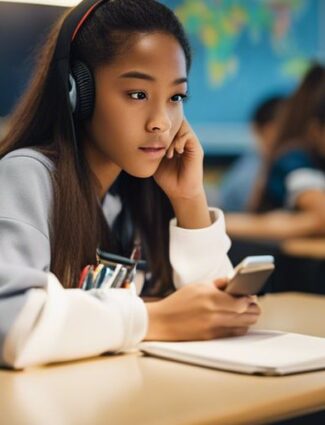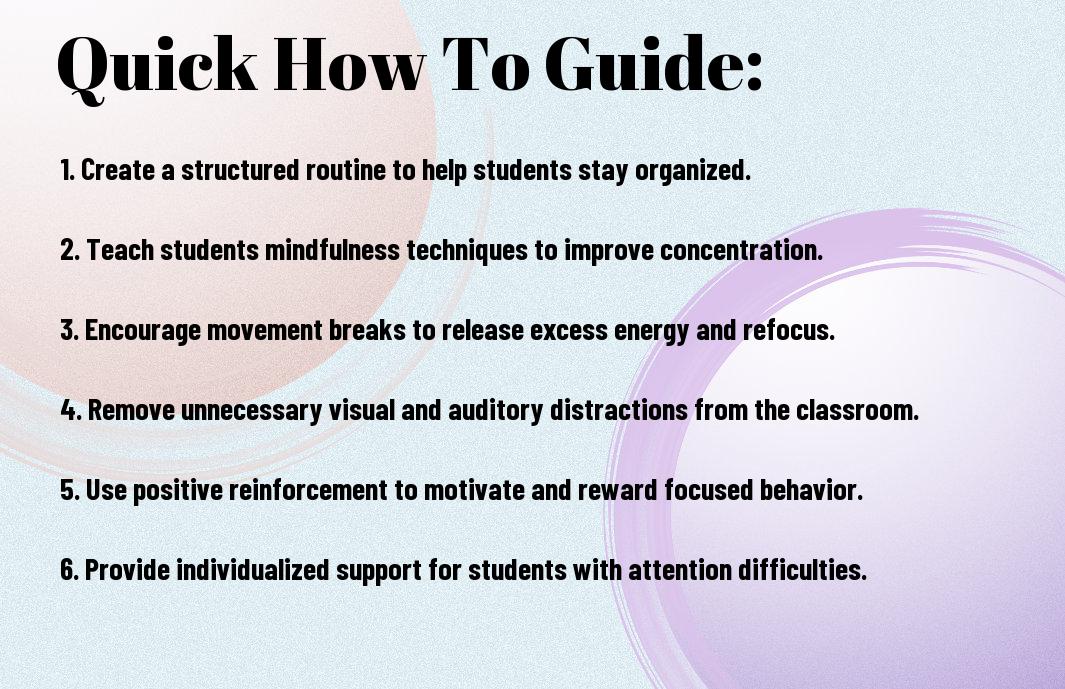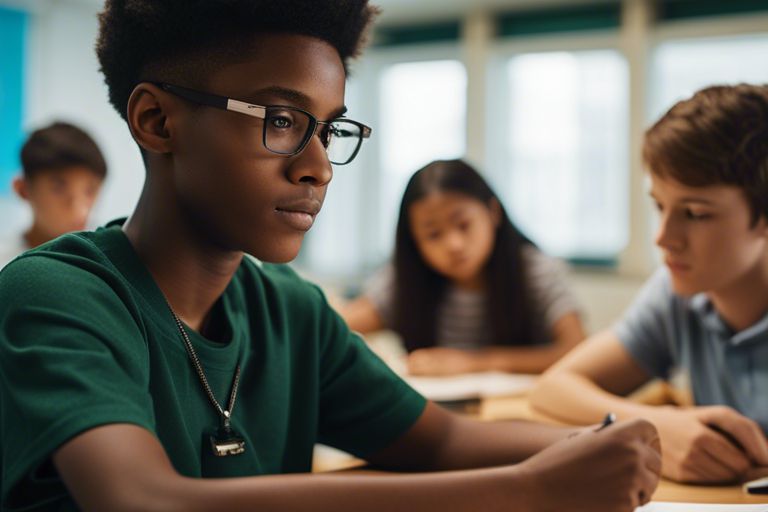How to Help Middle School Students Manage Distractions and Improve Focus in Class

Do you find middle school students struggling to manage distractions and improve focus in class? It’s no surprise that maintaining concentration in a classroom full of distractions can be challenging for adolescents. However, there are effective strategies you can implement to help your students stay on task and engaged during lessons.
Establishing clear expectations and routines in the classroom is key to helping students manage distractions and improve focus. By setting clear guidelines for behavior and participation, you provide a structured environment that supports their learning. Additionally, creating a designated workspace for each student can help minimize distractions and promote concentration. Furthermore, incorporating active learning techniques and varied teaching methods can help keep students engaged and focused on the lesson. By implementing these strategies, you can help your middle school students optimize their learning experience and succeed academically.
Key Takeaways:
- Establish Clear Expectations: Set clear guidelines and expectations for behavior and focus in the classroom to help students understand what is required of them.
- Teach Time Management Skills: Help middle school students develop time management skills to better prioritize tasks and manage their time effectively.
- Provide a Structured Environment: Create a structured learning environment with minimal distractions to help students stay focused and on task.
- Use Visual Aids and Technology Wisely: Incorporate visual aids and technology into lessons in a way that enhances learning and minimizes distractions.
- Encourage Mindfulness and Self-Regulation: Teach students techniques for staying present and managing their own distractions through mindfulness and self-regulation strategies.

Factors Contributing to Distractions
One of the key factors contributing to distractions for middle school students is the environment in which they are learning. This can include noisy classrooms, cluttered workspaces, and even the layout of the classroom itself. Another factor is the ever-present lure of digital devices, which can lead to constant notifications and temptations to check social media or play games. Additionally, personal factors such as fatigue, hunger, or stress can also play a significant role in distracting students. This combination of internal and external distractions can make it difficult for students to maintain focus and engage effectively in their learning.
- Noisy classrooms
- Cluttered workspaces
- Digital devices
- Fatigue, hunger, or stress
This can significantly impact their ability to succeed academically and can contribute to a lack of engagement in the classroom.
External Distractions and Their Impact
External distractions such as noise, visual stimuli, and interruptions from classmates can have a significant impact on a student’s ability to focus in class. These distractions can make it difficult for you to concentrate on the lesson being taught, leading to reduced learning outcomes and engagement. Additionally, the constant lure of digital devices and social media notifications can pull you away from the task at hand, making it challenging to maintain focus on classroom activities.
Internal Distractions and Student Focus
Internal distractions, such as feelings of stress, hunger, or fatigue, can also have a significant impact on your ability to focus in class. These factors can affect your cognitive abilities and make it challenging to concentrate, engage, and participate in classroom activities. Additionally, personal thoughts and worries may also distract you from the lesson, making it difficult to absorb and retain the information being presented.
It’s essential to recognize the impact of both internal and external distractions on your ability to focus in class and take proactive steps to minimize their influence on your learning experience.

Strategies for Managing External Distractions
For middle school students, managing external distractions is essential for improving focus in the classroom. Here are some strategies to help you minimize external distractions and create an optimal learning environment.
Creating an Optimal Learning Environment
Creating an optimal learning environment is crucial for minimizing external distractions. Make sure your classroom is organized and free from clutter. Clear and organized spaces can help you focus better and reduce the potential for distractions. Additionally, proper lighting and comfortable seating can also play a significant role in improving your ability to concentrate in class. By creating a comfortable and conducive environment, you can better manage external distractions and stay focused on your studies.
Setting Boundaries with Technology
In today’s digital age, technology can be a significant source of distraction for middle school students. In order to manage external distractions, it’s important to set boundaries with technology. Establishing specific times for technology use and designating tech-free zones can help you minimize distractions and stay focused during class. Additionally, implementing rules for phone usage and encouraging the use of technology for educational purposes only can also help you stay on track and improve your focus during school hours.
Approaches to Internal Distractions
Not all distractions in the classroom are external. Sometimes, students may struggle with internal distractions that hinder their ability to focus on the task at hand. It’s important to address these internal distractions and provide students with tools to help them manage their thoughts and emotions.
Mindfulness and Focus Techniques
One approach to managing internal distractions is to teach students mindfulness and focus techniques. By practicing mindfulness, you can train your mind to stay present and focused on the task at hand. Encourage students to take a few moments each day to practice deep breathing or meditation, which can help them clear their minds and improve their ability to concentrate. Additionally, introducing simple focus exercises, such as visualizations or guided imagery, can help students develop their concentration skills and reduce internal distractions.
Addressing Personal and Emotional Distractions
Addressing personal and emotional distractions is another important aspect of helping middle school students manage their focus in class. Encourage students to reflect on their emotions and identify any personal issues that may be affecting their ability to concentrate. By acknowledging and addressing their emotions, students can better manage their personal distractions and improve their focus in the classroom. Additionally, fostering a supportive and empathetic classroom environment can help students feel comfortable sharing their feelings and seeking assistance when needed.
It’s also important to educate students about the impact of personal and emotional distractions on their academic performance. Help them understand that ignoring these distractions can have long-term negative effects on their learning and overall well-being. Encourage them to seek help from a trusted adult or counselor if they are struggling with personal or emotional distractions that are impacting their focus in class.
Involving Parents and Caregivers
Keep communication open with parents and caregivers to ensure that they are aware of the strategies being implemented in the classroom to help their child manage distractions and improve focus. Encourage them to reinforce these strategies at home to provide a consistent environment for the student.
Communication Strategies for Home and School
When it comes to communication between home and school, it’s important to establish a clear line of dialogue. Keep parents informed about what is happening in the classroom, and ask for their input on how they can support their child’s focus. Discuss the specific distractions you are targeting in class and ask the parents if they are present at home as well. This way, you can work together to create a consistent approach to managing distractions. Additionally, be open to feedback from parents about what strategies are working at home, and adjust your approach accordingly.
At-Home Practices to Support Focus
Encourage parents and caregivers to create a dedicated study space at home where distractions are minimized. This space should be quiet, well-lit, and free from electronic devices or other potential interruptions. Additionally, establishing a consistent daily routine can help middle school students stay focused. This routine should include designated study times and breaks, as well as a consistent bedtime. Encouraging physical activity and healthy eating habits can also contribute to improved focus at home. And finally, limit screen time and set clear boundaries around the use of electronic devices.
Collaborating with Students
After recognizing the importance of involving middle school students in managing distractions and improving focus, you can start by collaborating with them. By working together, you can gain a better understanding of their needs and challenges, and tailor solutions that are more effective and sustainable. Here are some ways to collaborate with your students in addressing these issues.
Involving Students in Solution-Seeking
When it comes to managing distractions and improving focus, involving students in seeking solutions can be highly beneficial. Encourage them to share their thoughts and ideas on what strategies could work best for them. Giving them a voice in the process can increase their sense of ownership over the solutions, making them more likely to actively participate and adhere to the agreed-upon strategies. You can hold group discussions or use anonymous suggestion boxes to gather their input. By involving them in the solution-seeking process, you demonstrate that you value their perspective and are committed to finding solutions that work for everyone.
Individual and Group Goal Setting
Another effective way to collaborate with middle school students is by involving them in individual and group goal setting. Encourage your students to set specific, achievable goals for managing distractions and improving focus. These goals could range from reducing screen time to utilizing specific focus techniques. By setting goals, students can take ownership of their progress and work towards measurable outcomes. Additionally, you can facilitate group goal setting sessions where students collectively establish guidelines for minimizing distractions in the classroom. This not only fosters accountability but also creates a supportive environment where everyone is working towards a common objective.
By involving your students in the solution-seeking process and empowering them to set individual and group goals, you are fostering a collaborative approach to managing distractions and improving focus. Your students will feel more engaged, empowered, and committed to making positive changes. It’s important to remember that the success of these strategies will depend on your ongoing support and encouragement. Keep the lines of communication open and regularly check in with your students to assess their progress and make any necessary adjustments. Remember, collaboration is key to finding effective solutions together.
Leveraging Educational Technology
Unlike traditional classroom methods, leveraging educational technology can help middle school students manage distractions and improve focus in class. With the right tools and strategies, you can create an environment that promotes engagement and learning, while minimizing disruptions.
Tools to Enhance Focus and Learning
There are various educational technology tools that can help enhance focus and learning in the classroom. For example, interactive whiteboards and educational apps can make lessons more engaging and interactive, capturing your attention and helping you stay focused. Additionally, tools such as noise-cancelling headphones or ambient background music can create a conducive environment for learning, minimizing distractions and helping you concentrate on the task at hand. These tools can also help cater to different learning styles and preferences, making the learning experience more personalized and effective.
Limiting Counterproductive Tech Usage
While educational technology can be beneficial, it’s important to be mindful of counterproductive tech usage that can hinder focus and productivity. For example, excessive use of social media, gaming, or non-educational websites during class time can be major distractions. It’s important to set boundaries and guidelines for tech usage in the classroom to ensure that it’s being used for educational purposes. Encouraging students to use technology responsibly and emphasizing the importance of staying focused during class can help mitigate distractions and improve overall learning outcomes.
Professional Development for Educators
To help middle school students manage distractions and improve focus in class, it is important for educators to undergo professional development that equips them with the necessary tools and knowledge to address these issues effectively. By staying informed about the latest research and best practices, educators can create a learning environment that fosters focus and minimizes distractions for their students.
Training on Focus and Distraction Management
Professional development opportunities that focus on training educators in focus and distraction management are essential for equipping teachers with the skills they need to help their students stay on task. Workshops and seminars can provide valuable insights and practical strategies that educators can implement in the classroom to promote better focus and minimize distractions. These training sessions can cover topics such as effective classroom management techniques, incorporating mindfulness practices, and leveraging technology for educational purposes while minimizing its potential for distraction.
Keeping Up-to-date with Research
Staying informed about the latest research on attention and focus is crucial for educators as it allows them to incorporate evidence-based practices into their teaching. Professional development opportunities that focus on keeping up-to-date with research can provide educators with access to the latest findings in cognitive psychology, educational technology, and classroom management strategies. By integrating the most current and relevant research into their teaching, educators can better understand the factors that impact their students’ ability to focus and address distractions effectively.
Recap of Key Strategies and Tips
During professional development sessions, educators should receive a recap of key strategies and tips for helping middle school students manage distractions and improve focus in class. This may include creating a conducive learning environment, establishing clear expectations for behavior and participation, incorporating movement and brain breaks, and providing students with tools and techniques for self-regulation. By reinforcing these key strategies, educators can ensure that they are well-equipped to address distractions and promote focus in the classroom effectively.
- Creating a conducive learning environment
- Establishing clear expectations for behavior and participation
- Incorporating movement and brain breaks
- Providing students with tools and techniques for self-regulation
Knowing and implementing these key strategies will help you create a more focused and productive learning environment for your middle school students.
Encouraging Continued Effort and Adaptation
Professional development should also focus on encouraging educators to continuously adapt and refine their approaches to addressing distractions and facilitating focus in the classroom. This may involve ongoing support and mentorship to help educators implement the strategies they have learned, as well as providing opportunities for reflection and self-assessment. By encouraging continued effort and adaptation, educators can continuously improve their ability to create a classroom environment that supports students’ focus and minimizes distractions.
FAQ
Q: Why do middle school students struggle with managing distractions and improving focus in class?
A: Middle school students are at a stage in their development where they are easily distracted by both internal and external stimuli. Their rapidly changing bodies and minds can lead to increased emotional and social distractions, while the increasing academic demands can be overwhelming. Additionally, the prevalence of technology and social media can further contribute to their difficulty in maintaining focus during class.
Q: What strategies can teachers use to help middle school students manage distractions?
A: Teachers can implement several strategies to help students manage distractions and improve focus in class. These can include creating a structured and organized classroom environment, providing clear and consistent expectations for behavior, using positive reinforcement and rewards for staying on task, and differentiating instruction to cater to different learning styles. Additionally, incorporating movement and hands-on activities can help engage students and maintain their focus.
Q: How can parents support their middle school students in developing better focus and attention in class?
A: Parents can play a crucial role in helping their middle school students manage distractions and improve focus in class. They can create a conducive study environment at home, establish consistent routines and schedules, limit screen time and electronic distractions, and provide guidance and supervision when it comes to managing homework and assignments. Additionally, open communication with teachers and school staff can help parents stay informed about their child’s progress and any challenges they may be facing in the classroom.